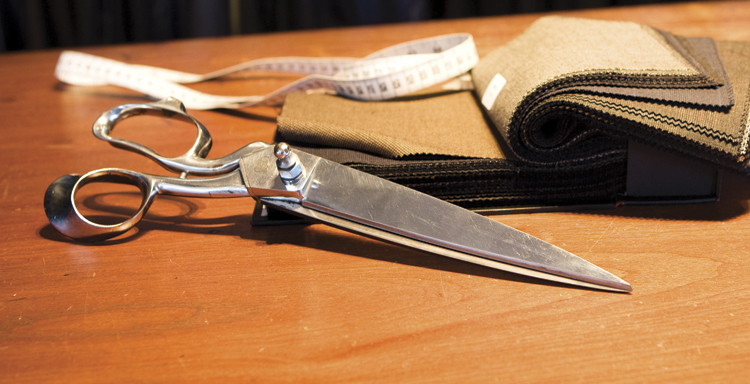Frank Sinatra was famed for his blue eyes and knack for carrying a tune, but it was his ability to work magic in a suit and tilted fedora that secured him a place in history as a male style icon. Like other leading men of his generation, from Cary Grant to Clark Gable, Sinatra favoured bespoke tailoring and was a regular on Savile Row, home to the London tailors who for over 200 years have safely guarded the exacting standards that underpin the craft of making customised clothing entirely by hand.
While the bespoke tailors of London’s glamorous Savile Row have been widely recognised for their discrete contribution to the styling of some of the world’s most exceptional men, less is known of the heritage of bespoke tailoring in Australia’s sartorial history. Nestled in the heart of Sydney’s financial district, J.H.Cutler is the story of a four-generation tailoring business, now led by esteemed bespoke tailor John Handel Lawson Cutler, whose 125-year legacy of making clothes for the city’s elite offers a unique window into an often-overlooked segment of Australian history.
Recently hailed by Forbes magazine as one of the top bespoke tailors in the world, J.H.Cutler holds a reputation for impeccable craftsmanship. Yet when the business opened for trade in Sydney’s King Street in 1884, it was at the inception of Cutler’s great-grandfather Joseph Handel Cutler who, beyond a few years training as a tailor’s apprentice, had no background in the clothing industry. His family had migrated from the English Midlands in the mid 1800s and his father, an engineer by trade, found work in the mining town of Ballarat. When Joseph Handel Cutler left the mining town as a teenager to try his luck in Sydney, he arrived in a city where fashion was beginning to flourish.
“Even in the 1820s, observers of colonial life were astonished at the tasteful and civilised nature of Sydney, with its fine homes, degree of commercial activity and elegant retail facilities,” writes historian Margaret Maynard in her account of clothing in colonial Australia, Fashioned from Penury. Yet despite the important contribution that tailors made to early colonial Sydney, tailoring as a trade still bore some uncertainty. Speaking of his great-grandfather’s decision to start his own business, John Cutler suggests the risk was informed by a passion that still runs through the business today.
“He had a vision to go out and do his own thing rather than simply having the comfort of being a tailor and sitting in the workroom with everybody else,” he says. “It was this vision that made the whole thing happen. That has continued as we see the evolution of this company. It is hard for family businesses to last beyond two or three generations, but here each generation has had a genuine passion for the trade.”
Cutler discovered his own passion for tailoring during his schooling and would visit the shop, which by then had moved to Bligh Street, to absorb the craft. At 18, Cutler travelled to London where he spent three years studying at the Tailor and Cutter Academy in Soho, not far from Carnaby Street and just a few streets away from Savile Row. It was the heyday of the swinging 60s and sharp tailoring was experiencing a renaissance thanks to the dapper style of pop outfits like The Beatles, who in 1968 set up offices at number 3 Savile Row. Like his father and grandfather before him, Cutler also spent time at prestigious wool house Dormeuil Freres and he attributes his strong ties today with the finest suppliers in Britain and Italy to these formative years spent in London’s fashion heart.
Now having recently relocated to larger premises in a heritage listed art deco building on O'Connell Street, Cutler's growing business greets the future with optimism, despite recent challenges to the craft including relaxed standards in the industry over the use of the term "bespoke". Historically, bespoke dates back to the days when a gentleman would select his cloth that was then spoken for and the true bespoke tailor crafts each garment specifically to the measurements of his client entirely by hand and without the use of a pre existing pattern.
In June, a group of Savile Row tailors complained to the Advertising Standards Authority of a menswear retailer offering bespoke suits that were in fact machine made in Germany. The complaint was dismissed with the Authority ruling the historic term has moved on to encompass the more general idea of made-to-measure clothing.
Cutler points out that bespoke tailoring has faced many challenges in the past century but ultimately the machine made suit will never match the personal service of bespoke, where the manipulation of the finest materials becomes an intimate vehicle for the client's wishes. "Clothing is an outward expression of an inward feeling or belief,” he suggests. “As my grandfather said, you have to fit 50 per cent of the body and 50 per cent of the mind.”
Prices for a bespoke Cutler suit vary according to fabric and style but average at $6000. A cost can be provided on private consultation, to be made by appointment.
J.H.Cutler is at Level 6, 12 O’Connell Street, Sydney
